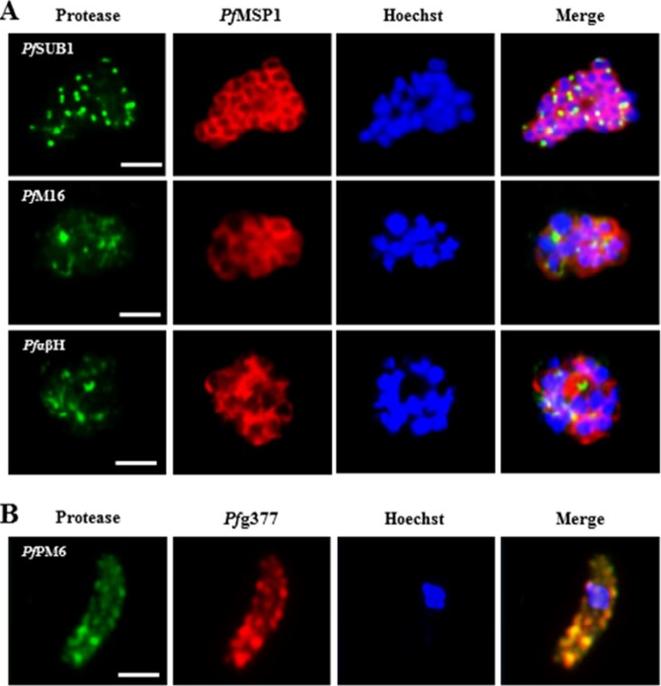PCHAS_0410600 plasmepsin VI, putative
Disruptability [+]
| Species | Disruptability | Reference | Submitter | |
|---|---|---|---|---|
| P. berghei ANKA |
Possible |
RMgm-884 | Imported from RMgmDB | |
| P. berghei ANKA |
Possible |
RMgm-97 | Imported from RMgmDB | |
| P. falciparum 3D7 |
Possible |
USF piggyBac screen (Insert. mut.) | USF PiggyBac Screen | |
Mutant phenotypes [+]
| Species | Stage | Phenotype | Reference | Submitter |
|---|---|---|---|---|
| P. berghei ANKA | Asexual |
No difference |
RMgm-884 | Imported from RMgmDB |
| P. berghei ANKA | Asexual |
No difference |
RMgm-97 | Imported from RMgmDB |
| P. berghei ANKA | Gametocyte |
No difference |
RMgm-884 | Imported from RMgmDB |
| P. berghei ANKA | Gametocyte |
No difference |
RMgm-97 | Imported from RMgmDB |
| P. berghei ANKA | Ookinete |
No difference |
RMgm-884 | Imported from RMgmDB |
| P. berghei ANKA | Ookinete |
No difference |
RMgm-97 | Imported from RMgmDB |
| P. berghei ANKA | Oocyst |
Difference from wild-type |
RMgm-884
Normal numbers of oocysts. Oocysts lack sporozoite formation and appear as 'enlarged, empty' oocysts |
Imported from RMgmDB |
| P. berghei ANKA | Oocyst |
Difference from wild-type |
RMgm-97
Normal numbers of oocysts are produced: 114% of wild type (73-151%). Sporozoite formation (sporulation) is absent in the 'mature' oocysts. |
Imported from RMgmDB |
| P. berghei ANKA | Sporozoite |
Difference from wild-type |
RMgm-884
Normal numbers of oocysts. Oocysts lack sporozoite formation and appear as 'enlarged, empty' oocysts. No salivary gland sporozoites. |
Imported from RMgmDB |
| P. berghei ANKA | Sporozoite |
Difference from wild-type |
RMgm-97
No sporozoites are produced. No tramission to C57BL/6 mice by mosquito bite |
Imported from RMgmDB |
Imaging data (from Malaria Metabolic Pathways)

In-depth analysis of protease localization. A) IFAs using polyclonal mouse antisera directed against PfSUB1, PfαβH and PfM16 were used to investigate the granular localization of these proteases in merozoite-containing mature schizonts (in green). The merozoites were visualized via immunolabelling with polyclonal rabbit antisera directed against PfMSP1 (in red). PfM16 localized to granular structures in schizonts, which did not coincide with the merozoites B) Immunolabeling of osmiophilic bodies using polyclonal rabbit antisera directed against Pfg377 (in red) was employed to demonstrate an accumulation of PfPM6, labeled with the respective mouse antisera (in green), in these organelles. Hoechst 33342 staining was used to highlight the parasite nuclei (in blue). Bar, 2 μm. Results are representative of two independent experiments. The localization of PfPM6 in female gametocytes was don by co-localization experiments were performed, using rabbit antibodies directed against the osmiophilic body protein Pfg377. The double-labelling assays demonstrated that PfPM6 is present in these organelles.Weißbach T, Golzmann A, Bennink S, Pradel G, Julius Ngwa C. Transcript and protein expression analysis of proteases in the blood stages of Plasmodium falciparum. Exp Parasitol. 2017 Mar 25. [Epub ahead of print]
See original on MMP
Protein expression profile of selected P. falciparum proteases. IFAs using polyclonal mouse antisera directed against 12 of the proteases was used to demonstrate protein expression in the asexual blood stages (R, ring; T, trophozoite; iS, immature schizont; mS, mature schizont) and gametocytes (GC stages III, IV and V) as well as in macrogametes (MaG) at 20 min post-activation (in green). The asexual and the sexual blood sstages were visualized via immunolabelling with polyclonal rabbit antisera against PfMSP1 and Pfs230, respectively (in red). Hoechst 33342 staining was used to highlight the parasite nuclei (in blue). Bar, 5 μm. Results are representative of three to four independent experiments.Weißbach T, Golzmann A, Bennink S, Pradel G, Julius Ngwa C. Transcript and protein expression analysis of proteases in the blood stages of Plasmodium falciparum. Exp Parasitol. 2017 Mar 25. [Epub ahead of print]
See original on MMPMore information
| PlasmoDB | PCHAS_0410600 |
| GeneDB | PCHAS_0410600 |
| Malaria Metabolic Pathways | Localisation images Pathways mapped to |
| Previous ID(s) | PC000527.00.0, PC300601.00.0, PCAS_041060, PCHAS_041060 |
| Orthologs | PBANKA_0409700 , PF3D7_0311700 , PKNH_0830700 , PVP01_0828500 , PVX_119690 , PY17X_0412200 |
| Google Scholar | Search for all mentions of this gene |